Flames of War: Mid-War Dynamic Points for 2024
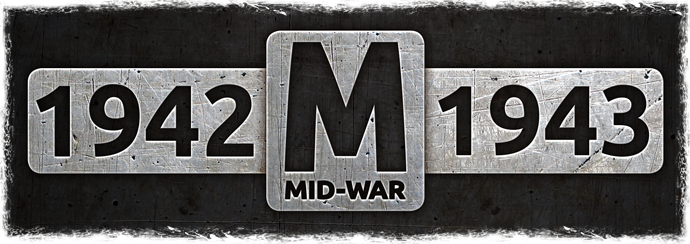
By Richard Steer
The latest round of “Dynamic Points” for Flames of War has been finalized. If you are not familiar with the term, a Dynamic Points document is an update that Battlefront publishes that adjusts the cost of units in the game without needing to re-release the books. If you are playing a game using Dynamic Points, treat any units in the document as costing what they are listed there, while any units not in the update continue to use the points given in the books.
So far this concept has only been applied to the Mid-War era, with the 2024 version being the second round of adjustments for the era. The update can be downloaded for free from the FOW website, and have also been applied to the Forces of War list builder.
What has changed?
Battlefront’s stated goals for the 2024 update are to focus on the balance of:
- Armored cars and light tanks,
- Medium tanks,
- Anti-tank guns, and
- Soviet infantry with a 4+ Save.
The first two items on the list had already been adjusted in the 2023 Dynamic Points, but looking at recent Mid-War tournaments, it’s easy to see why further changes were needed. Competitive lists have continued to typically be built around large numbers of armored cars or light tanks. The mainstays of the era, such as the Sherman, Panzer IV, and T-34, were usually quite rare in tournaments.
Let’s have a look at each of these goals and see how things have changed.
Armored Cars and Light Tanks
The issue with armored cars and light tanks comes when they can be spammed. Typically this would take the form of formations of SdKfz 222s or L6/40s, backed up by anti-tank support units such as Marders or Elefants. The light vehicles have enough machine guns and Anti-tank 5 shots to overwhelm a “balanced” opponent while offering enough Careful targets that a balanced force simply doesn’t have enough anti-tank shots to deal with them. Battlefront’s approach here has been to ramp up the cost significantly, making it harder to fit this type of force into a typical game.
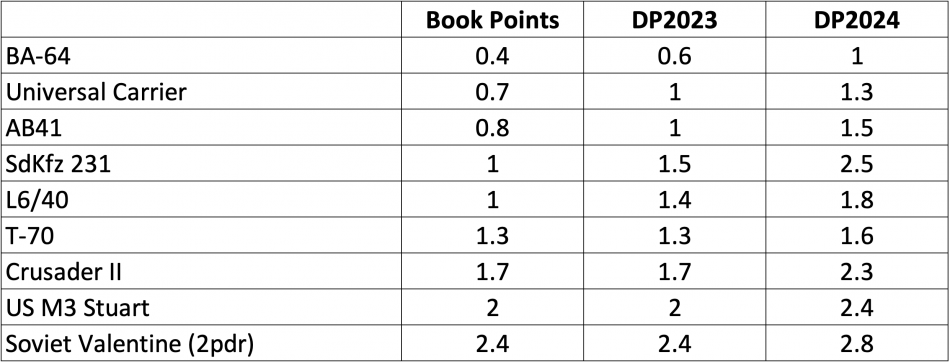
This table shows what has happened: the cheapest vehicles in the game have increased significantly, while the more expensive ones have increased less. The BA-64 now costs 2.5 times what it originally did in the books, the spammable L6/40 costs nearly twice as much, and a more expensive “light” tank, the Soviet Valentine, is only about 1.2 times more expensive than in the books.

Medium Tanks
Medium tanks suffered from the opposite problem. These were the standard tanks for the period, yet have been unpopular in competitive play. Their price means that you can usually only fit less than 10 in a force, so they don’t have enough anti-tank shots to deal with spam, while their side armor is low enough that eventually, you will fail enough armor saves to lose the game.

Just as the problem is opposite to the Lights, so is the solution. The cheapest medium tanks have dropped in price by less than 10%, while some of the top-end tanks from late in the period are now almost 30% cheaper than in the original books.
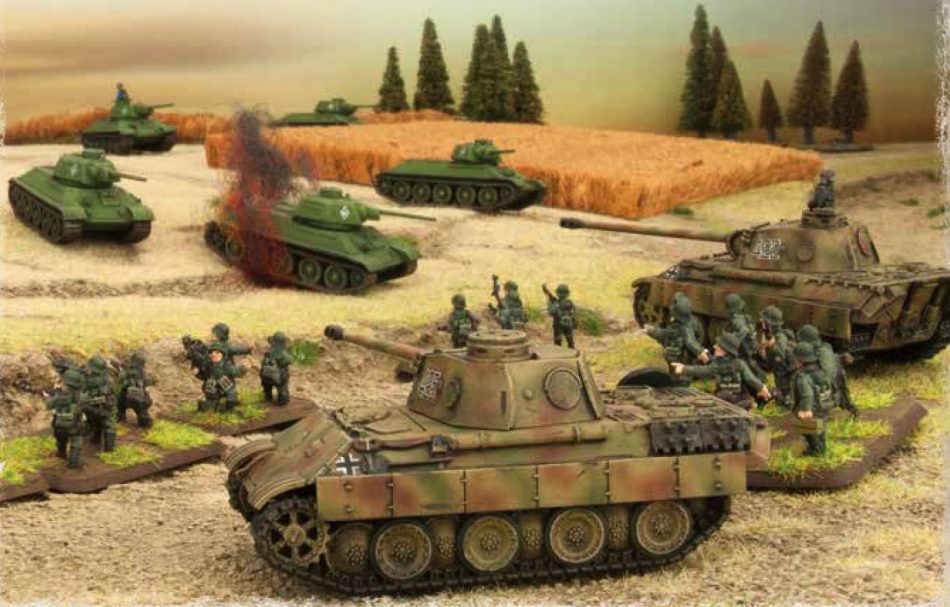
Anti-tank Guns
It’s commonly viewed that Attacking is better than Defending in 4th Edition. There are several reasons for this, but perhaps the most significant one has been the cost of light tanks relative to infantry teams. The increase in cost for light armor is a step towards resolving this, but Battlefront has doubled down by also reducing the cost of anti-tank guns.

These changes won’t have a huge impact on the cost of existing lists, maybe saving a couple of points per gun platoon. Some forces could use those points to upgrade the guns to a better weapon, such as German forces switching their 5cm guns out for 7.5cm guns. For other forces that don’t have that range of options, those savings will help offset increases elsewhere.
These changes have also flowed across into self-propelled anti-tank weapons, with many of these becoming cheaper. Notably, the increase that was applied to Marders in DP2023 has been scaled back slightly.

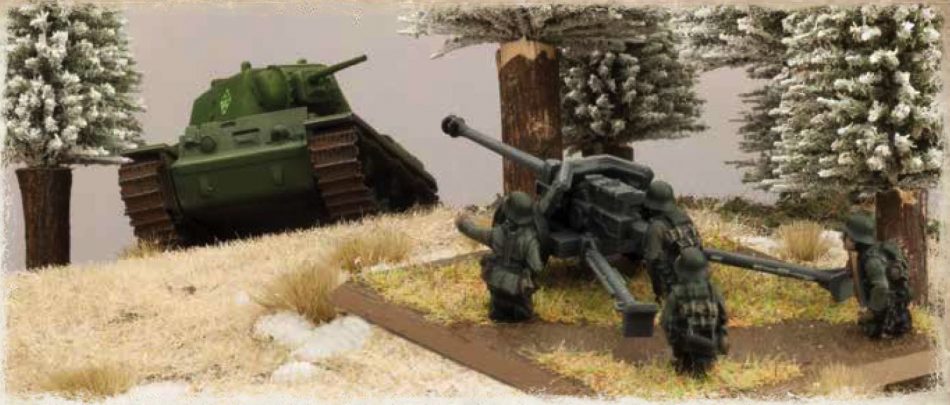
Soviet Infantry
Some of the strongest feedback after the publication of the 2023 Dynamic Points was that they didn’t adjust the cost of Soviet infantry. Battlefront has responded to those comments by significantly reducing the cost of the Soviet 4+ Save infantry units.

Their 4+ Save is still the big downside of these units (although this is at 3+ To Hit, which is much better than the 2+ in earlier editions), but hopefully, a nearly 20% reduction in cost will go a long way toward encouraging players to give Soviet infantry a try.
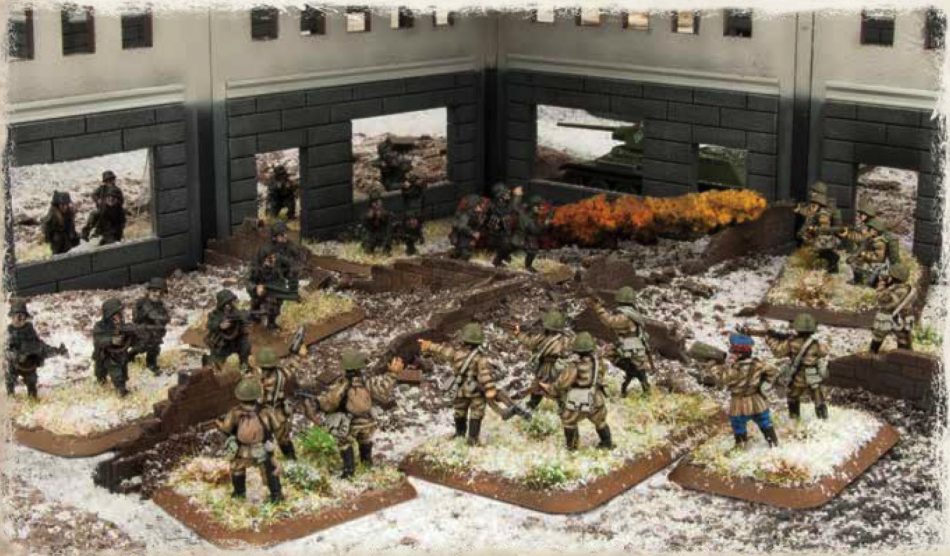
Other Changes
There are a number of other changes in the document. For example:
- Some mortar units have increased in cost.
- German gun-armed aircraft (Hs129 and Ju87G) have been reduced to 10pts per flight.
- Soviet KV-1 tanks have been returned to their book points.
What does it mean for the meta?
It will be interesting to see how players respond to these changes. Have we seen the last of the SdKfz 222 and L6/40 swarms? What will replace them as the go-to competitive list? Do individual armored car patrols still have a role at their increased price? Will the reduction in medium tank prices be canceled out by the reduction in anti-tank unit prices?
The effect on the Mid-War meta is more than just whether a particular unit has changed. One might look at the British Grant Troop, which has dropped from 18pts to 17pts, and say that it’s such a trivial change that it doesn’t make the Grant Squadron any better.
However, the flip side of the coin is that the forces that have been causing problems for medium tank lists have gone up in price. Previously, 18 points could have bought 18 L6/40s. Now, those three Grants are worth the same as only 10 L6/40s. The Italian player will either have to purchase fewer light tanks or reduce the amount of support they have. Both of these options weaken the L6/40 list, which should make Grants relatively that much better.
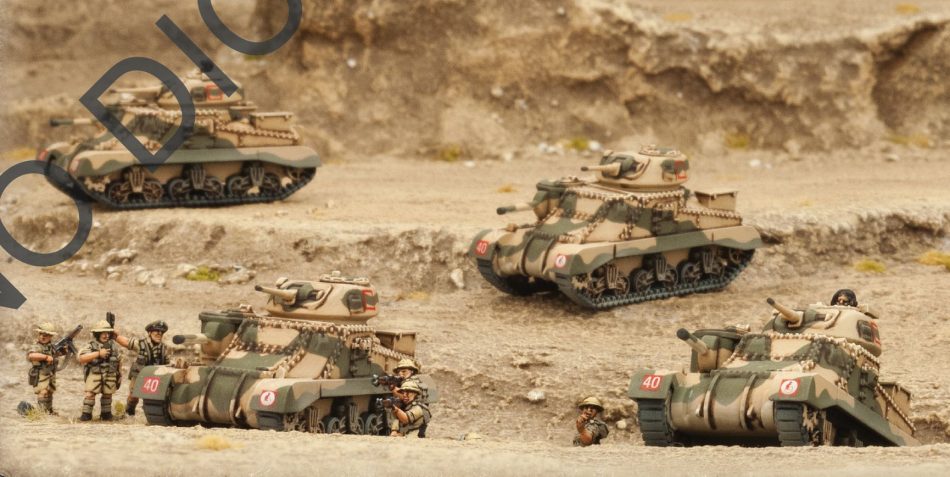
It is the same with a Panzer III company. You are saving less than half a point per tank, with a company of 10 tanks costing 47 points instead of 50 points. Under the book points your ten tanks would have cost the same as 30 Honeys or Crusader IIs. With the new Dynamic Points, it will only be facing 20, which should make German tank companies a much more viable option.
The most important thing for me is that Dynamic Points isn’t just a tournament thing for competitive players. Even if you are a casual player who doesn’t play in tournaments, I recommend downloading the new Dynamic Points document and giving it a try in your Mid-War games. It has the potential to shake up your lists, encourage you to try new combinations, and freshen up the game.

I think the SU-152 problem is more to do with unit size in V4 ?
I agree – the two-vehicle unit is a big drawback, and 21pts probably still isn’t cheap enough to make them worthwhile. I’d prefer the prices to account for the effect of unit size, rather than just using a flat cost per team.
October 1943 they should be in units of 3 , don’t if people would use them more then ?
http://armchairgeneral.com/rkkaww2/structure/AFV/SPguns/strspgun.htm?fbclid=IwAR0utW3—L___Laz5mKgv58h012PcBjOm6cFCwSZZaZGMGCbvV0VNZYl3o
I don’t think I would use SU-152s even if they were in a unit of three. That would be 32pts, and I don’t think there are too many situations where that’s a better option than four SU-85s for the same cost.